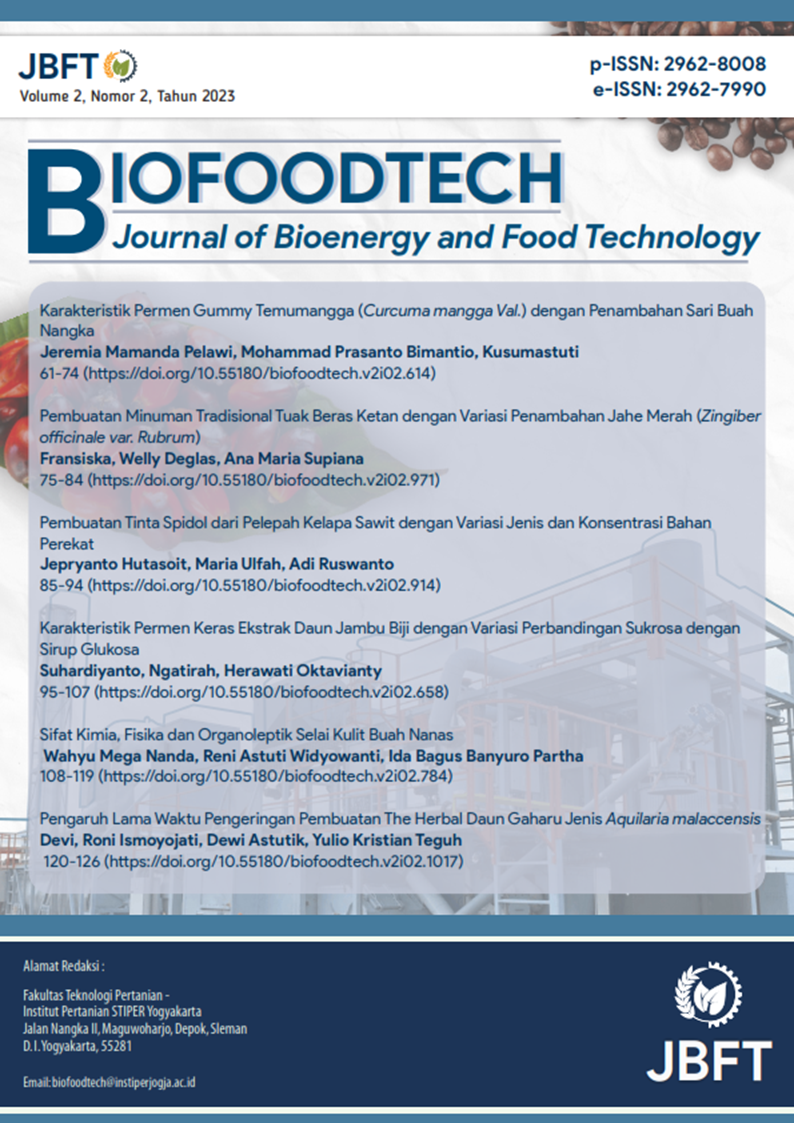Pengaruh Lama Waktu Pengeringan Pembuatan Teh Herbal Daun Gaharu Jenis Aquilaria malaccensis
DOI:
https://doi.org/10.55180/biofoodtech.v2i02.1017Kata Kunci:
Agarwood Leaves, Tea, Drying ProcessAbstrak
Research aims to find out the potential use of agarwood leaves as a beverage product of agarwood leaf tea. Agarwood leaves h
Research aims to find out the potential use of agarwood leaves as a beverage product of agarwood leaf tea. Agarwood leaves have not been processed and utilized by the community to the maximum because of the lack of knowledge and technical guidance on processing agarwood leaves. This research is carried out by preparing tools and materials, then conducting a selection of agarwood leaves, agarwood leaves that have been selected and selected are washed with running water, and then twisted until the wind dry. After twisting, drying is carried out with a temperature variation of 30 ºC for 6 days, 40 ºC for 4 days and 50 ºC 2 days. After drying with the treatment of variations in the temperature of agarwood leaves, it is done to reduce the size using a blender and then sifting is carried out so as to produce tea powder. The tea powder that was applied was carried out water content analysis, organoleptic tests, phytochemical tests and Tannins. The results of the observations made are the lowest water content of agarwood leaf tea is best at 500C treatment for 2 Days and panelists' favorability level for agarwood tea (Aquilaria malaccensis) is on a scale of 3-4 which is quite likeable to like, where panelists prefer tea from agarwood leaves with a temperature treatment of 50 ºC for 2 days.
ave not been processed and utilized by the community to the maximum because of the lack of knowledge and technical guidance on processing agarwood leaves. This research is carried out by preparing tools and materials, then conducting a selection of agarwood leaves, agarwood leaves that have been selected and selected are washed with running water, and then twisted until the wind dry. After twisting, drying is carried out with a temperature variation of 30 ºC for 6 days, 40 ºC for 4 days and 50 ºC 2 days. After drying with the treatment of variations in the temperature of agarwood leaves, it is done to reduce the size using a blender and then sifting is carried out so as to produce tea powder. The tea powder that was applied was carried out water content analysis, organoleptic tests, phytochemical tests and Tannins. The results of the observations made are the lowest water content of agarwood leaf tea is best at 500C treatment for 2 Days and panelists' favorability level for agarwood tea (Aquilaria malaccensis Lamk) is on a scale of 3-4 which is quite likeable to like, where panelists prefer tea from agarwood leaves with a temperature treatment of 50 ºC for 2 days.
Referensi
Anjarsari, I. R. D. (2016). Katekin teh Indonesia: Prospek dan manfaatnya. Kultivasi, 15(2), Article 2. https://doi.org/10.24198/kultivasi.v15i2.11871
Buckle, K. A., R.A., E., & G.H., F. (1987). Ilmu pangan. UI Press.
Daroini, O. S. (2006). Kajian Proses Pembuatan Teh Herbal Dari Campuran Teh Hijau (Camellia sinensis), Rimpang Bangle (Zingiber cassumunea Roxb.) dan Daun ceremai (Phyllanthus acidus (L) Skeels.) [Skripsi]. ITB Bogor.
Fitrayana, C. (2014). Pengaruh lama dan suhu pengeringan tehadap karakteristik teh herbal pare (Momordica charantia L) [Skripsi]. Universitas Pasundan.
Harahap, S. B. (2020). Pengaruh Perbandingan Konsentrasi Sukrosa dengan Sirup Glukosa dan Lama Pemasakan Terhadap Mutu Kembang Gula Kelapa [Skripsi]. Jurusan Teknologi Pertanian Universitas Sumatera Utara.
Huriawati, F., Yuhanna, W. L., & Mayasari, T. (2016). PENGARUH METODE PENGERINGAN TERHADAP KUALITAS SERBUK SERESAH Enhalus acoroides DARI PANTAI TAWANG PACITAN. Bioeksperimen: Jurnal Penelitian Biologi, 2(1), Article 1. https://doi.org/10.23917/bioeksperimen.v2i1.1579
Rusli, S., & Rahmawan, D. (1988). Pengaruh Cara Pengirisan dan Tipe Pengeringan Terhadap Mutu Jahe Kering. Buletin Penelitian Tanaman Rempah dan Obat, 3(2), 80–83.
Sudarmadji, S., Haryono, B., & Suhardi. (1989). Analisa Bahan Makanan dan Pertanian. Penerbit Liberty.
Tanuwijaya, Y. (2009). Upacara Minum Teh Sebagai Bagian Kebudayaan Masyarakat Cina [Skripsi]. Universitas Indonesia.
Wang, H., Provan, G. J., & Helliwell, K. (2000). Tea flavonoids: Their functions, utilisation and analysis. Trends in Food Science & Technology, 11(4–5), 152–160. https://doi.org/10.1016/S0924-2244(00)00061-3
Unduhan
Diterbitkan
Cara Mengutip
Terbitan
Bagian
Citation Check
Lisensi
Hak Cipta (c) 2023 BIOFOODTECH : Journal of Bioenergy and Food Technology

Artikel ini berlisensiCreative Commons Attribution-NonCommercial-ShareAlike 4.0 International License.











